#Philippe Bertin
Text
A la Lueur des Contes : programme de juin 2024

Voici le programme de juin 2024 de "A la Lueur des Contes" :
En juin on change de braquet, on passe au vert et on met les chaussures de combat... ou presque ! Nous avons hâte de vous accueillir pour "Forêt d'Histoires, Contes au Vert » du 7 au 16 juin 2024 dans le Pays de Montbéliard. C'est une programmation pensée sur mesure pour l'événement PMA Capitale Française de la Culture 2024, en partenariat avec la manifestation nationale Les Nuits des Forêts. La Lueur donne la part belle aux récits, à la musique, à la nature, aux pratiques au grand air et au partage. À tout vite dans la forêt !
À noter qu'un second round PMA CFC24 est prévu en octobre avec d'autres propositions artistiques en direction d'autres communes de l'agglomération, ça va dépoter".
Vendredi 7 juin 2024 20h00, THULAY « pré de la renardière » (4 route de Sevralon)
Lénaïc EBERLIN & PHILIPPE RIEGER - ZAWA PINIM, l'homme Jaguar. À la découverte de la forêt Amazonienne et de ses mythes. Tout en contant, le conteur cuisine un plat traditionnel. Tout public dès 12 ans - Chacun apporte sa chaise et sa lampe torche.
Samedi 8 juin 2024 20h00, AUTECHAUX-ROIDE – Salle de la Crochère
Mapie CABURET, Stann DUGUET & Pascale BERTHOMIER - Les ELLES de la Forêt. Un récit au féminin-futur accompagné d'une forêt de violoncelles. Tout public dès 10 ans.
Dimanche 9 juin 2024 14h30, NEUCHATEL-URTIERE – rdv à la Mairie
Mapie CABURET & Gaëtan GOUGET - Balade contée + goûter tiré du sac. Quand les seigneurs de Neuchâtel habitaient en leurs châteaux et autres contes de la forêt. Tout public dès 6 ans.
Lundi 10 juin 2024 18h00, ROCHES-LES-BLAMONT
Axelle GAGNARD - Le Yoga des arbres (complet)
Mardi 11 juin 2024 20h00, NOIREFONTAINE Salle des fêtes intercommunale, Villars-sous-Dampjoux
Alice ZIMMERMANN - Conférence "La Forêt, la Vie". Pour comprendre le rôle primordial de la forêt : préserver la vie. Public adulte.
Mercredi 12 juin 2024 16h00 et 18h00, VALENTIGNEY – Bois du Vernois
Céline BERTIN - Sophronature. Une approche ludique de la sophrologie en forêt. 16h00 : la Forêt avec tous nos sens (familles dès 6 ans) - Inscription obligatoire. 18h00 : immersion en Forêt (pour les adultes) (complet).
Jeudi 13 juin 2024 18h00, ECURCEY
Christian NIGGLI - Découverte de la marche nordique. Pour expérimenter ce type de marche agréablement. Public adulte - Inscription obligatoire.
Vendredi 14 juin 2024 20h00, ECURCEY – Lieu-dit « Chassagne » (suivre rue du Pâquis, puis les pancartes CONTES)
Mapie CABURET & Jan VANEK - La veillée des loups. Un spectacle conte et musique envoûtant pour découvrir la magie des loups. Tout public dès 8 ans - Chacun apporte sa chaise et sa lampe torche.
Samedi 15 juin 2024– 20h00 // AUTECHAUX-ROIDE « La Crochère », cabane des chasseurs
Nathalie LEONE - Robin Dubois. Le récit incisif et drôle d'un justicier de notre époque. Tout public dès 12 ans - Chacun apporte sa chaise et sa lampe torche.
Dimanche 16 juin 2024 de 10h00 à 17h00, Circuit AUTECHAUX-ROIDE > ECURCEY, départ parking salle de la Crochère à Autechaux-Roide
Emmanuelle FILIPPI-HAHN & Nathalie LEONE - Balade contée + repas tiré du sac. Deux conteuses pour mille histoires d'arbres et de forêts... Tout public dès 6 ans.
Mardi 18 juin 2024 19h30, VALENTIGNEY : PREMICES, l'atelier de Gaëtan GOUGET
Tout public dès 8 ans – Entrée libre. Présentation du travail des stagiaires à la Maison des Contes en Est le mardi 18 Juin à 19h30, suivi du grignotage de ce que chacun voudra bien apporter. Entrée libre, sans réservation
Maison des Contes en Est, 5 rue des Ecoles, VALENTIGNEY
Jeudi 27 juin 2024 20h15, VALENTIGNEY : BANQUET D’HISTOIRES, le LaB'Oratoire de Mapie CABURET
Tout public dès 8 ans – Entrée libre. Elles / Ils ont concocté, mariné, assaisonné, mijoté, mitonné, laissé bouillonner leurs histoires pendant près d’une année. Venez déguster leurs saveurs variées si particulières… La soirée sera suivie du grignotage de ce que chacun voudra bien apporter. Entrée libre, sans réservation.
Maison des Contes en Est, 5 rue des Ecoles, VALENTIGNEY.
infos > [email protected] ou www.alalueurdescontes.fr
Read the full article
0 notes
Photo










Playground (Laura Wandel, 2021).
#playground#playground (2021)#un monde#un monde (2021)#laura wandel#maya vanderbeque#frédéric noirhomme#nicolas rumpl#philippe bertin#vanessa evrard
53 notes
·
View notes
Photo

Pendant ce temps-là à l’Essaïon...
#Un peu de pub pour les amis#advertising#Trois quart d'heure avant l'armistice#Essaïon#Essaïon Théâtre#Théâtre#l'Officiel Des Spectacle#Philippe Sabres#Isabelle Fournier#Philippe Bertin
1 note
·
View note
Photo

West Indies, Med Hondo (1979)
#Med Hondo#Daniel Boukman#Robert Liensol#Cyril Aventurin#Fernand Berset#Roland Bertin#Gérard Bloncourt#Toto Bissainthe#Philippe Clévenot#Monique Couturier#Jean Paul Denizon#Gabriel Glissant#Georges Hilarion#Théo Légitimus#Blanche Lolia#Maîthé Mansoura#Hélène Vincent#François Catonné#Georges Rabol#Frank Valmont#Youcef Tobni#1979
9 notes
·
View notes
Text
George IV and Napoléon’s table

This is the coronation portrait of George IV, done by Thomas Lawrence in 1821 - and I really adore this painting for a very specific reason.



Here, this table is the reason. The table is quite famous and bears the rather fancy name of “Table of the Great Commanders of Antiquity”. Emperor Napoléon commissioned the table in 1806 (although it seems as the table was not completed prior to 1812) and the whole thing costed 29.025 Frances - an enormous sum of money. In the middle of the revolving top-section is the profile head of Alexander the Great surrounded by twelve other “great commanders of antiquity”. The artists and suppliers were Louis-Bertin Parant, Antoine Béranger and Pierre-Philippe Thomire.
After Napoléon’s final defeat at Waterloo in 1815, the table was gifted to George IV (then still Prince Regent) by the new and grateful French King Louis XVIII. George IV really liked this gift and decided it was the perfect spot to rest his crown on. I am not sure if that was his primary intention, but I think it in quite a power-move
#george iv#napoleon bonaparte#waterloo#1815#1821#coronation#table#alexander the great#thomas lawrence#french history#english history#english monarchy#prinny#art#louis xviii
84 notes
·
View notes
Video
youtube
Promotional video for Toho Stage’s 2021 production of Marie Antoinette (マリー・アントワネット), playing Jan. 28-Feb. 21, 2021.
Cast (New additions for the 2021 run bolded):
Sonim (ソニン) /Natsumi Kon (昆 夏美) - Margrid Arnaud
Rena Sasamoto (笹本玲奈)/Hanafusa Mari (花總まり)- Marie Antoinette
Mario Tashiro (田代万里生) /Shouma Kai (甲斐翔真) - Axel Von Fersen
Rio Uehara (上原理生) /Ryunosuke Onoda (小野田龍之介) - The Duc d’Orléans/Philippe Égalité
Yuichi Harada (原田優一) - Louis XVI
Hajime Komada (駒田 一) - Leonard
Mao Ayabuki (彩吹真央) - Rose Bertin
Kanami Ayano - The Princesse de Lamballe
Ryuji Kamiyama (上山竜治) /Tatsuya Kawaguchi (川口竜也 ) - Jacques Hébert
Noboru Nakayama (中山 昇) - The Archbishop de Rohan
Katsuyuki Nakanishi (中西勝之) - Boehmer
Asakuma Rinro (朝隈濯朗) - Dr. Guillotin
Koji Aoyama (青山航士) - Robespierre
Shinichiro Hara (原 慎一郎) - Danton
Atsuko Iezuka (家塚敦子) - Madame de la Motte
22 notes
·
View notes
Note
Robe de cours from 1700-1720s look like they have slim hips while the ones from the 1740s-1770s. Those one have really wide hips.
Aaah... yes. I’m sorry I don’t know if this is a question? No? Well, I’m assuming it is you, Anonymous, giving us all a start for a cool conversation ;)
The fashionable silhouette for the 18th century starts slim, gets really wide at the middle of the century, and ends being slim again. This is seen in the fashionable dress, and also the robe de cour (plural robes de cour), even though the bodice of the dress remains the same pretty much until the end of the century, the skirt shape and size changes with the fashion of the decade. At the end of the century, after the French Revolution and with the Regency fashion things for the robes de cour went, well, weird. You’ll see at the end of the post.
This dress is also called by other names, so you can find info about the grand habit, grand habit de cour, or stiff bodied gown, and all of them are the same dress. Because why not. LOL. It evolved from the mantua worn at court during the 17th century.
Here a small timeline for the robes de cour:

“Engraving of Marie Thérèse de Bourbon, Princesse de County”, ca. 1690.

“Princess Anne”, 1728, Philippe Mercier, Hertford Town Council.

“Portrait of Lady Frances Montagu”, ca. 1734, Charles Jervas.

Mantua, 1740s, Victoria & Albert Museum.
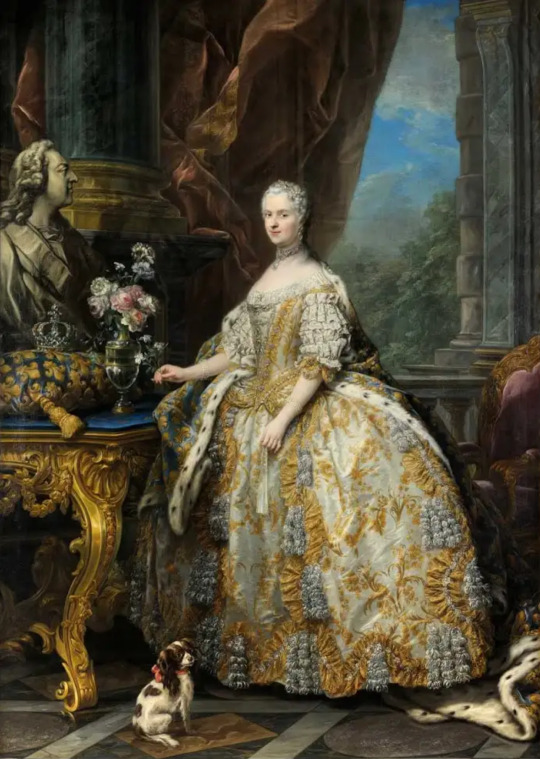
Marie Leszczinska, queen of France, 1747, Carle Van Loo.

British court dress, ca. 1750, Metropolitan Museum of Art.

Coronation dress (robe de cour) of Queen Lovisa Ulrika of Sweden, 1751, Royal Armoury, Sweden.
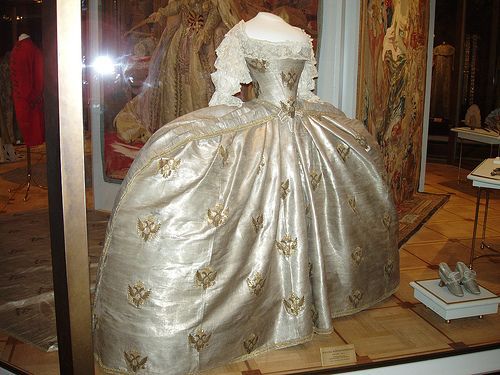
Catherine the Great’s coronation robe, 1762.

Sofia Magdalenas wedding dress (robe de cour), 1766, Statens Historiska Museer.

Maria Carolina of Austria, about 1760-70, Martin van Meytens.
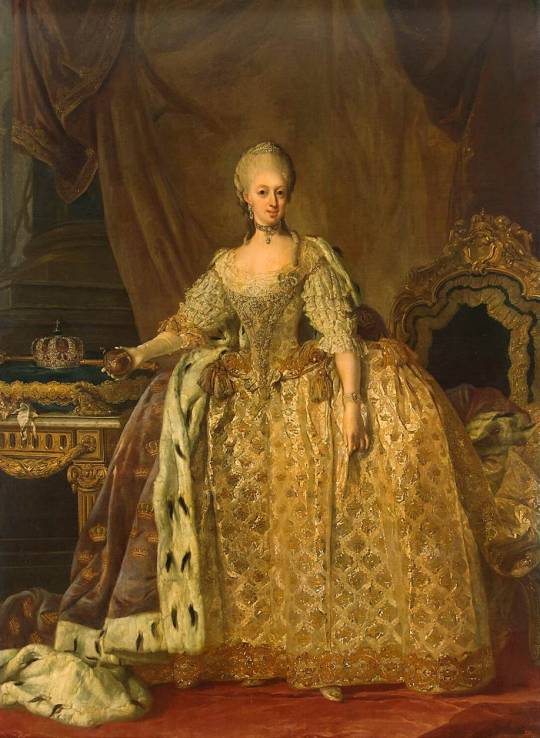
Sofia Magdalena of Denmark, 1773-74, Lorens Pasch the Younger.

“Habit de cour de satin cerise”, 1779, fashion plate from Gallerie des Modes.

Marie Antoinette of Austria, Queen of France, 1783, Louise Élisabeth Vigée Le Brun.
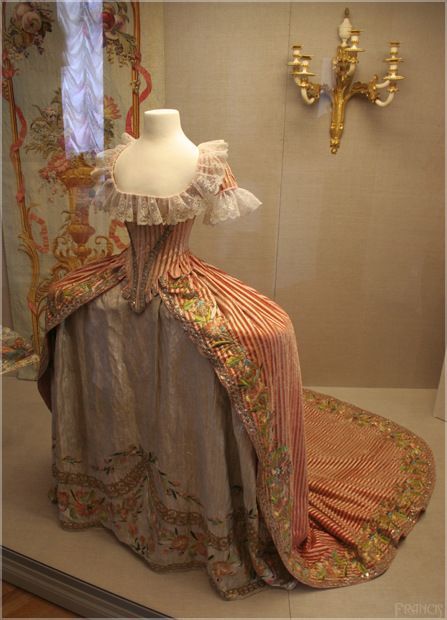
Robe de cour of Ekaterina Pavlovna, late 1780s, attributed to Rose Bertin.

Robe de cour of Grand Duchess Ekaterina Pavlovna, 1790s.

Her Royal Highness the Princess of Wales in her court dress on the fourth of June, 1807, as authentically taken from the real dress by Mrs. Webb of Pall Mall. London.
#Anonymous#robe de cour#court gown#18th century#18th century fashion#womenswear#court#european courts#marie antoinette#1780s#1783#louise elisabeth vigee le brun#french court#habit de cour#1770s#1779#denmark#france#danish court#sweden#swedish court#sofia magdalena of denmark#Lorens Pasch the Younger#maria carolina of austria#austrian court#Martin van Meytens#1760s#1766#Queen Lovisa Ulrika of Sweden#1750s
152 notes
·
View notes
Text
Irritator challengeri
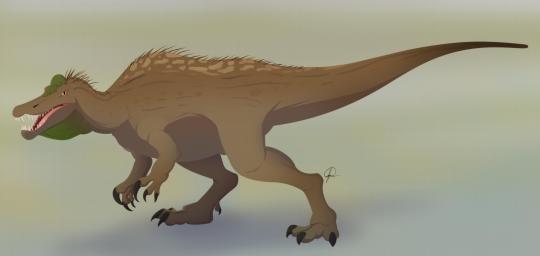
By José Carlos Cortés
Etymology: The One That Irritated
First Described By: Martill et al., 1996
Classification: Dinosauromorpha, Dinosauriformes, Dracohors, Dinosauria, Saurischia, Eusaurischia, Theropoda, Neotheropoda, Averostra, Tetanurae, Orionides, Megalosauroidea, Megalosauria, Spinosauridae, Spinosaurinae
Status: Extinct
Time and Place: Between 110 and 108 million years ago, in the Albian of the Early Cretaceous

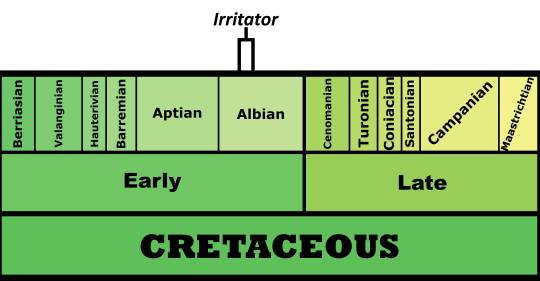
Irritator is known from the Romualdo Member of the Santana Formation in Brazil

Physical Description: Irritator was a Spinosaurid, so the weird crocodile-mimicking theropods that roamed the Cretaceous landscape across the Southern hemisphere (and some of Europe). Irritator, however, is not known from very much material, despite having loads written about it. It was one of the smaller members of the Spinosaur group, only about 7.5 meters long and not weigh more than one tonne - which may actually indicate it could have still had some sort of fluffy integument, though this still seems unlikely based on its ecology. As a Spinosaur, Irritator would have been fairly bulky, with a long and vaguely crocodilian skull. Its skull also featured a long thin crest going from the midline to the eye, where it flattened into a bulge - this was probably some sort of display structure. Little is known of the rest of its skeleton, but it is known to have had a long and well-clawed hand. It probably had some sort of sail on its back, but it probably was a shorter one, and whether or not its legs were a normal size is unknown.

By Alexander Vieira, CC BY-SA 4.0 (Irritator is on the far right, in green)
Diet: Irritator would have mainly fed upon fish and other aquatic organisms.
Behavior: Irritator, being a Spinosaur, spent most of its time in the water, swimming about and searching for food. Since it was rather small, it would have been able to fit in smaller streams of water than most of its other relatives. Though, since it probably still had fairly decent legs, it also would have spent a good amount of time on the land, surveying the shore for food and seeking out prey. Its long snout would then be used to grab fish and other animals from the water, using the lightweight instrument to grab food it might not be able to reach otherwise. While swimming, it would be able to use that snout to reach even more food than before, ducking its head underwater or doing the reverse to hide from land sources of prey. Its very powerful neck muscles would have also been extremely helpful in grabbing and holding onto thrashing prey.

By Fred Wierum, CC BY 3.0
Irritator was probably warm-blooded, and used its sail more for display than for keeping warm. This display structure may have been able to change color based on blood circulation or environment in order to send different messages to other members of the species. The crest on the center of the snout also probably served similar features, for displaying to one another. It seems likely that Irritator, like most other dinosaurs, took care of its young; but there is no evidence either way to support that hypothesis.
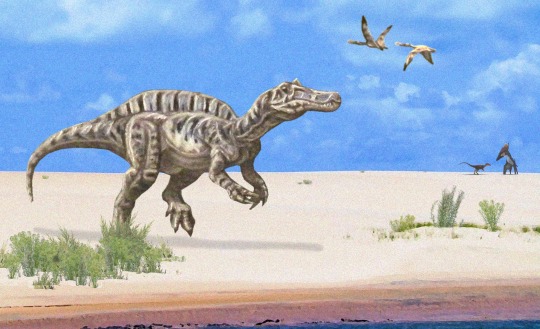
By PaleoGeekSquared, CC BY 3.0
Ecosystem: Irritator lived in the Romualdo Environment of Brazil, which was a basin of lakes surrounded by rivers and other wetland environments, filled to the brim with a wide variety of plantlife. Nearby was the burgeoning Atlantic Ocean, making this a Spinosaur’s favorite place of all. Here there were a wide variety of early flowering plants like magnolias, seagrasses, and lilies - all of which were associated heavily with this aquatic environment. There were many types of ray-finned fish, which would have been the primary source of prey for Irritator, as well as lobe-finned fish which would have also been decent sources of food. Sharks seem to have been rare. There were plenty of turtles too, including one of the earliest sea turtles Santanachelys. This was the land of extreme pterosaurs, including Anhanguera, Arirpesaurus, Barbosania, Brasileodactylus, Cearadacytlus, Maaradactylus, Santanadactylus, Tapejara, Thalassodromeus, Tropeognathus, Tupuxuara, and Unwindia. There was also a Notosuchian, Araripesuchus. There were other dinosaurs there too - the compsognathid Mirischia and the Tyrannosauroid Santanaraptor, which would have mainly fed on small animal prey.

By Scott Reid
Other: Irritator was found as part of the illegal fossil trade, initially mistake for a pterosaur, then a maniraptoran, before being finally identified as a spinosaur. The confusion surrounding this fossil - and the fact that the snout had been artificially elongated by the fossil traders - lead to its name. Its position within the Spinosaurs is well supported, and it seems to have been at least somewhat closely related to Spinosaurus itself, rather than Baryonyx on the other end of the family tree.
~ By Meig Dickson
Sources under the Cut
Allain, Ronan; Xaisanavong, Tiengkham; Richir, Philippe; Khentavong, Bounsou (2012-04-18). "The first definitive Asian spinosaurid (Dinosauria: Theropoda) from the early cretaceous of Laos". Naturwissenschaften. 99 (5): 369–377.
Amiot, R.; Buffetaut, E.; Lécuyer, C.; Wang, X.; Boudad, L.; Ding, Z.; Fourel, F.; Hutt, S.; Martineau, F.; Medeiros, A.; Mo, J.; Simon, L.; Suteethorn, V.; Sweetman, S.; Tong, H.; Zhang, F.; Zhou, Z. (2010). "Oxygen isotope evidence for semi-aquatic habits among spinosaurid theropods". Geology. 38 (2): 139–142.
Arden, T.M.S.; Klein, C.G.; Zouhri, S.; Longrich, N.R. (2018). "Aquatic adaptation in the skull of carnivorous dinosaurs (Theropoda: Spinosauridae) and the evolution of aquatic habits in Spinosaurus". Cretaceous Research. In Press: 275–284.
Aureliano, Tito; Ghilardi, Aline M.; Buck, Pedro V.; Fabbri, Matteo; Samathi, Adun; Delcourt, Rafael; Fernandes, Marcelo A.; Sander, Martin (2018-05-03). "Semi-aquatic adaptations in a spinosaur from the Lower Cretaceous of Brazil". Cretaceous Research. 90: 283–295.
Bantim, Renan A.M.; Saraiva, Antônio A.F.; Oliveira, Gustavo R.; Sayão, Juliana M. (2014). "A new toothed pterosaur (Pterodactyloidea: Anhangueridae) from the Early Cretaceous Romualdo Formation, NE Brazil". Zootaxa. 3869 (3): 201–223.
Barrett, Paul; Butler, Richard; Edwards, Nicholas; Milner, Andrew R. (2008-12-31). "Pterosaur distribution in time and space: An atlas". Zitteliana Reihe B: Abhandlungen der Bayerischen Staatssammlung Fur Palaontologie und Geologie. 28: 61–107.
Benson, R.B.J.; Carrano, M.T.; Brusatte, S.L. (2009). "A new clade of archaic large-bodied predatory dinosaurs (Theropoda: Allosauroidea) that survived to the latest Mesozoic". Naturwissenschaften. 97 (1): 71–78.
Benyoucef, Madani; Läng, Emilie; Cavin, Lionel; Mebarki, Kaddour; Adaci, Mohammed; Bensalah, Mustapha (2015-07-01). "Overabundance of piscivorous dinosaurs (Theropoda: Spinosauridae) in the mid-Cretaceous of North Africa: The Algerian dilemma". Cretaceous Research. 55: 44–55.
Bertin, Tor (2010-12-08). "A catalogue of material and review of the Spinosauridae". PalArch's Journal of Vertebrate Palaeontology. 7.
Bertozzo, F., B. Favaretto, M. Bon and FM Dalla Vecchia. 2013. The wallpaper of Ouranosaurus nigeriensis Taquet, 1976 (Ornithischia, Ornithopoda) exhibited at the Natural History Museum of Venice: history of the find and perspectives for detailed studies [The paratype of Ouranosaurus nigeriensis Taquet, 1976 (Ornithischia, Ornithopoda) exhibited at the Museum of Natural History of Venice: history of discovery and prospects for detailed studies]. Bulletin of the Natural History Museum of Venice 64 : 119-130
Bittencourt, Jonathas; Kellner, Alexander (2004-01-01). "On a sequence of sacrocaudal theropod dinosaur vertebrae from the Lower Cretaceous Santana Formation, northeastern Brazil". Arq Mus Nac. 62: 309–320.
Brito, Paulo; Yabumoto, Yoshitaka (2011). "An updated review of the fish faunas from the Crato and Santana formations in Brazil, a close relationship to the Tethys fauna". Bulletin of Kitakyushu Museum of Natural History and Human History, Ser. A. 9.
Buffetaut, E.; Ouaja, M. (2002). "A new specimen of Spinosaurus (Dinosauria, Theropoda) from the Lower Cretaceous of Tunisia, with remarks on the evolutionary history of the Spinosauridae" (PDF). Bulletin de la Société Géologique de France. 173 (5): 415–421.
Buffetaut, E.; Martill, D.; Escuillié, F. (2004). "Pterosaurs as part of a spinosaur diet". Nature. 430 (6995): 33.
Candeiro, C. R. A., A. G. Martinelli, L. S. Avilla and T. H. Rich. 2006. Tetrapods from the Upper Cretaceous (Turonian–Maastrichtian) Bauru Group of Brazil: a reappraisal. Cretaceous Research 27:923-946
Candeiro, C. R. A., A. Cau, F. Fanti, W. R. Nava, and F. E. Novas. 2012. First evidence of an unenlagiid (Dinosauria, Theropoda, Maniraptora) from the Bauru Group, Brazil. Cretaceous Research 37:223-226
Carrano, M. T., R. B. J. Benson, and S. D. Sampson. 2012. The phylogeny of Tetanurae (Dinosauria: Theropoda). Journal of Systematic Palaeontology 10(2):211-300
Charig, A.J.; Milner, A.C. (1997). "Baryonyx walkeri, a fish-eating dinosaur from the Wealden of Surrey". Bulletin of the Natural History Museum of London. 53: 11–70.
Cuff, Andrew R.; Rayfield, Emily J. (2013-05-28). "Feeding Mechanics in Spinosaurid Theropods and Extant Crocodilians". PLoS ONE. 8 (5): e65295.
Dal Sasso, Cristiano; Maganuco, Simone; Buffetaut, Eric; Mendez, Marco A. (2005-12-30). "New information on the skull of the enigmatic theropod Spinosaurus, with remarks on its size and affinities". Journal of Vertebrate Paleontology. 25 (4): 888–896.
de Lapparent de Broin, F. (2000). "The oldest pre-Podocnemidid turtle (Chelonii, Pleurodira), from the early Cretaceous, Ceará state, Brasil, and its environment". Treballs del Museu de Geologia de Barcelona. 9: 43–95.
Evers, Serjoscha W.; Rauhut, Oliver W.M.; Milner, Angela C.; McFeeters, Bradley; Allain, Ronan (2015). "A reappraisal of the morphology and systematic position of the theropod dinosaur Sigilmassasaurus from the 'middle' Cretaceous of Morocco". PeerJ. 3: e1323.
Ezcurra, M. D. 2009. Theropod remains from the uppermost Cretaceous of Colombia and their implications for the palaeozoogeography of western Gondwana. Cretaceous Research 30:1339-1344
Figueiredo, R.G.; Kellner, A.W.A. (2009). "A new crocodylomorph specimen from the Araripe Basin (Crato Member, Santana Formation), northeastern Brazil". Paläontologische Zeitschrift. 83 (2): 323–331.
Frey, E.; Martill, D.M. (1994). "A new Pterosaur from the Crato Formation (Lower Cretaceous, Aptian) of Brazil". Neues Jahrbuch für Geologie und Paläontologie, Abhandlungen. 194: 379–412.
Furtado, M. R., C. R. A. Candeiro, and L. P. Bergqvist. 2013. Teeth of Abelisauridae and Carcharodontosauridae cf. (Theropoda, Dinosauria) from the Campanian- Maastrichtian Presidente Prudente Formation (southwestern São Paulo State, Brazil). Estudios Geológicos 69(1):105-114
Gaffney, Eugene S.; de Almeida Campos, Diogenes; Hirayama, Ren (2001-02-27). "Cearachelys, a New Side-necked Turtle (Pelomedusoides: Bothremydidae) from the Early Cretaceous of Brazil". American Museum Novitates. 3319: 1–20.
Gaffney, Eugene S.; Tong, Haiyan; Meylan, Peter A. (2009-09-02). "Evolution of the side-necked turtles: The families Bothremydidae, Euraxemydidae, and Araripemydidae". Bulletin of the American Museum of Natural History. 300: 1–698.
Gibney, Elizabeth (2014-03-04). "Brazil clamps down on illegal fossil trade". Nature. 507 (7490): 20.
Hassler, A.; Martin, J.E.; Amiot, R.; Tacail, T.; Godet, F. Arnaud; Allain, R.; Balter, V. (2018-04-11). "Calcium isotopes offer clues on resource partitioning among Cretaceous predatory dinosaurs". Proc. R. Soc. B. 285 (1876): 20180197.
Henderson, Donald M. (2018-08-16). "A buoyancy, balance and stability challenge to the hypothesis of a semi-aquatic Spinosaurus Stromer, 1915 (Dinosauria: Theropoda)". PeerJ. 6: e5409
Hendrickx, C., and O. Mateus. 2014. Abelisauridae (Dinosauria: Theropoda) from the Late Jurassic of Portugal and dentition-based phylogeny as a contribution for the indentification of isolated theropod teeth. Zootaxa 3759(1):1-74
Hirayama, Ren (1998). "Oldest known sea turtle". Nature. 392 (6677): 705–708.
Holtz, Thomas; Molnar, Ralph E.; Currie, Philip (2004-06-12). "Basal Tetanurae". The Dinosauria: Second Edition. University of California Press. pp. 71–110.
Ibrahim, N.; Sereno, P.C.; Dal Sasso, C.; Maganuco, S.; Fabbri, M.; Martill, D.M.; Zouhri, S.; Myhrvold, N.; Iurino, D.A. (2014). "Semiaquatic adaptations in a giant predatory dinosaur". Science. 345 (6204): 1613–1616.
Kellner, A.W.A.; Campos, D.A. (1996). "First Early Cretaceous dinosaur from Brazil with comments on Spinosauridae". N. Jb. Geol. Paläont. Abh. 199 (2): 151–166.
Kellner, A.W.A. (1996). "Remarks on Brazilian dinosaurs". Memoirs of the Queensland Museum. 39 (3): 611–626.
Kellner, A.W.A.; Campos, D.A. (2000). "Brief review of dinosaur studies and perspectives in Brazil". Anais da Academia Brasileira de Ciências. 72 (4): 509–538.
Kellner, A.W.A. (2001). "New information on the theropod dinosaurs from the Santana Formation (Aptian-Albian), Araripe Basin, Northeastern Brazil". Journal of Vertebrate Paleontology. 21 (supplement to 3): 67A.
Kellner, A.W.A.; Campos, D.A. (2002). "The function of the cranial crest and jaws of a unique pterosaur from the early Cretaceous of Brazil". Science. 297 (5580): 389–392.
Kellner, A. W. A., S. A. K. Azevedo, E. B. Machado, L. B. Carvalho, and D. D. R. Henriques. 2011. A new dinosaur (Theropoda, Spinosauridae) from the Cretaceous (Cenomanian) Alcântara Formation, Cajual Island, Brazil. Anais da Academia Brasileira de Ciências 83(1):99-108
Lee, Yuong-Nam; Barsbold, Rinchen; Currie, Philip J.; Kobayashi, Yoshitsugu; Lee, Hang-Jae; Godefroit, Pascal; Escuillié, François; Chinzorig, Tsogtbaatar (2014). "Resolving the long-standing enigmas of a giant ornithomimosaur Deinocheirus mirificus". Nature. 515 (7526): 257–260.
Lopes, Reinaldo José (September 2018). "Entenda a importância do acervo do Museu Nacional, destruído pelas chamas no RJ". Folha de S.Paulo (in Portuguese).
Mabesoone, J.M.; Tinoco, I.M. (1973-10-01). "Palaeoecology of the Aptian Santana Formation (Northeastern Brazil)". Palaeogeography, Palaeoclimatology, Palaeoecology. 14 (2): 97–118.
Machado, E.B.; Kellner, A.W.A. (2005). "Notas Sobre Spinosauridae (Theropoda, Dinosauria)" (PDF). Anuário do Instituto de Geociências – UFRJ (in Portuguese). 28 (1): 158–173.
Machado, E.B.; Kellner, A.W.A.; Campos, D.A. (2005). "Preliminary information on a dinosaur (Theropoda, Spinosauridae) pelvis from the Cretaceous Santana Formation (Romualdo Member) Brazil". Congresso Latino-Americano de Paleontologia de Vertebrados. 2 (Boletim de resumos): 161–162.
Machado, E.B.; Kellner, A.W.A. (2008). "An overview of the Spinosauridae (Dinosauria, Theropoda) with comments on the Brazilian material". Journal of Vertebrate Paleontology. 28(3): 109A.
Martill, D. M., A. R. I. Cruickshank, E. Frey, P. G. Small, and M. Clarke. 1996. A new crested maniraptoran dinosaur from the Santana Formation (Lower Cretaceous) of Brazil. Journal of the Geological Society, London 153:5-8
Martill, David M. (2011). "A new pterodactyloid pterosaur from the Santana Formation (Cretaceous) of Brazil". Cretaceous Research. 32 (2): 236–243.
Martill, David; Frey, Eberhard; Sues, Hans-Dieter; Cruickshank, Arthur R.I. (2011-02-09). "Skeletal remains of a small theropod dinosaur with associated soft structures from the Lower Cretaceous Santana Formation of NE Brazil". Canadian Journal of Earth Sciences. 37 (6): 891–900.
Mateus, Octávio; Araujo, Ricardo; Natario, Carlos; Castanhinha, Rui (2011-04-21). "A new specimen of the theropod dinosaur Baryonyx from the early Cretaceous of Portugal and taxonomic validity of Suchosaurus". Zootaxa: 54–68.
Medeiros, M. A. 2006. Large theropod teeth from the Eocenomanian of northeastern Brazil and the occurrence of Spinosauridae. Revista Brasileira de Paleontologia 9(3):333-338
Medeiros, Manuel Alfredo; Lindoso, Rafael Matos; Mendes, Ighor Dienes; Carvalho, Ismar de Souza (August 2014). "The Cretaceous (Cenomanian) continental record of the Laje do Coringa flagstone (Alcântara Formation), northeastern South America". Journal of South American Earth Sciences. 53: 50–58.
Milner, Andrew; Kirkland, James (2007). "The case for fishing dinosaurs at the St. George Dinosaur Discovery Site at Johnson Farm". Utah Geological Survey Notes. 39 (3): 1–3.
Naish, D.; Martill, D.M.; Frey, E. (2004). "Ecology, Systematics and Biogeographical Relationships of Dinosaurs, Including a New Theropod, from the Santana Formation (?Albian, Early Cretaceous) of Brazil". Historical Biology. 16 (2–4): 57–70.
Naish, D., and D. M. Martill. 2007. Dinosaurs of Great Britain and the role of the Geological Society of London in their discovery: basal Dinosauria and Saurischia. Journal of the Geological Society, London 164:493-510
Pêgas, R.V.; Costa, F.R.; Kellner, A.W.A. (2018). "New Information on the osteology and a taxonomic revision of the genus Thalassodromeus (Pterodactyloidea, Tapejaridae, Thalassodrominae)". Journal of Vertebrate Paleontology. 38 (2): e1443273.
Rauhut, Oliver W.M. (2003). The interrelationships and evolution of basal theropod dinosaurs. London: The Palaeontological Association.
Rayfield, Emily J.; Milner, Angela C.; Xuan, Viet Bui; Young, Philippe G. (2007-12-12). "Functional morphology of spinosaur 'crocodile-mimic' dinosaurs". Journal of Vertebrate Paleontology. 27 (4): 892–901.
Sales, Marcos A.F.; Lacerda, Marcel B.; Horn, Bruno L.D.; de Oliveira, Isabel A.P.; Schultz, Cesar L. (2016-02-01). "The 'χ' of the Matter: Testing the Relationship between Paleoenvironments and Three Theropod Clades". PLOS ONE. 11 (2): e0147031.
Sales, Marcos (2017). "Contribuições à paleontologia de Terópodes não-avianos do Mesocretáceo do Nordeste do Brasil" (in Portuguese). 1. Universidade Federal do Rio Grande do Sul: 54.
Sales, Marcos A.F.; Schultz, Cesar L. (2017-11-06). "Spinosaur taxonomy and evolution of craniodental features: Evidence from Brazil". PLOS ONE. 12 (11): e0187070.
Sánchez-Hernández, B., M. J. Benton, and D. Naish. 2007. Dinosaurs and other fossil vertebrates from the Late Jurassic and Early Cretaceous of the Galve area, NE Spain. Palaeogeography, Palaeoclimatology, Palaeoecology 249:180-215
Sayão, Juliana; Saraiva, Antonio; Silva, Helder; Kellner, Alexander (2011). "A new theropod dinosaur from the Romualdo Lagerstatte (Aptian-Albian), Araripe Basin, Brazil". Journal of Vertebrate Paleontology. 31: supplement 2: 187.
Sereno, P.C.; Beck, A.L.; Dutheuil, D.B.; Gado, B.; Larsson, H.C.; Lyon, G.H.; Marcot, J.D.; Rauhut, O.W.M.; Sadleir, R.W.; Sidor, C.A.; Varricchio, D.; Wilson, G.P.; Wilson, J.A. (1998). "A long-snouted predatory dinosaur from Africa and the evolution of spinosaurids". Science. 282 (5392): 1298–1302.
Serrano-Martínez, Alejandro; Vidal, Daniel; Sciscio, Lara; Ortega, Francisco; Knoll, Fabien (2015). "Isolated theropod teeth from the Middle Jurassic of Niger and the early dental evolution of Spinosauridae". Acta Palaeontologica Polonica.
Sues, H.D.; Frey, E.; Martill, D.M.; Scott, D.M. (2002). "Irritator challengeri, a spinosaurid (Dinosauria: Theropoda) from the Lower Cretaceous of Brazil". Journal of Vertebrate Paleontology. 22 (3): 535–547.
Witmer, L.M. 1995.The Extant Phylogenetic Bracket and the Importance of Reconstructing Soft Tissues in Fossils. in Thomason, J.J. (ed). Functional Morphology in Vertebrate Paleontology. New York. Cambridge University Press. pp. 19–33.
Witton, Mark P. (2018-01-01). "Pterosaurs in Mesozoic food webs: a review of fossil evidence". Geological Society, London, Special Publications. 455 (1): 7–23.
Xu, X.; Currie, P.; Pittman, M.; Xing, L.; Meng, Q.; Lü, J.; Hu, D.; Yu, C. (2017). "Mosaic evolution in an asymmetrically feathered troodontid dinosaur with transitional features". Nature Communications. 8: 14972.
#Irritator challengeri#Irritator#Dinosaur#Spinosaur#Palaeoblr#Factfile#Dinosaurs#Megalosaur#Water Wednesday#Piscivore#South America#Cretaceous#Spinosaurine#prehistoric life#paleontology#prehistory#biology#a dinosaur a day#a-dinosaur-a-day#dinosaur of the day#dinosaur-of-the-day#science#nature
226 notes
·
View notes
Photo

Intense Fortunio !
À l’Opéra-Comique jusqu’au 22 décembre.
Fortunio
Comédie lyrique en quatre actes d’André Messager. Livret de Gaston Arman de Caillavet et Robert de Flers d’après Le Chandelier d’Alfred de Musset. Créé à l’Opéra Comique en 1907.
Direction musicale, Louis Langrée
Mise en scène, Denis Podalydès
Avec Cyrille Dubois, Anne-Catherine Gillet, Franck Leguérinel, Jean-Sébastien Bou, Philippe-Nicolas Martin, Thomas Dear, Aliénor Feix, Luc Bertin-Hugault
Choeur les éléments
Orchestre des Champs-Élysées
À lire le programme de la soirée, on s’attend à une bouffonnerie narrant une histoire badine dans laquelle un barbon provincial se fait cocufier par un soldat de passage en garnison. Un marivaudage sans prétention qui disserte de manière légère sur les caprices de l’amour. Un peinture sous forme de farce d’un milieu provincial et bourgeois où les règles du mariage ne suivent pas celles de l’amour.
Las ! Il n’en est rien ! Cette comédie lyrique, avec ses demi-caractères -personnages pittoresques, milieu bourgeois, grivoiserie- possède la fluidité et le mouvement rythmé tirant vers le comique. Celui-ci servi par la remarquable prestation de Louis Langrée et l’Orchestre des Champs-Elysées en parfaits compagnons de la scène avec une musique nerveuse sans cabotinage, très alerte et légère.
Franck Leguérinel incarne un maître André sur lequel repose l’essentiel de l’aspect comique de la pièce. Barbon dépassé, il espionne Jacqueline par jalousie. Son aveuglement et son idiotie le font passer à côté de sa vie. Décalé, toujours en retard de l’action, il ne fait que subir sans le savoir chaque évènement de la pièce. On est dans le schéma de l’arroseur arrosé, tout comme le capitaine Clavaroche. Faux stratèges, vrais ridicules.
Mais Louis Langrée et l’Orchestre des Champs-Elysées servent aussi une densité et une force nécessaire faisant accélérer les mouvements de coeur dans le décisif Acte III.
Car, cette comédie de 1907 est adaptée de la pièce Le Chandelier de Musset et par cela nous savons par avance que le sujet des infortunes de l’amour est traité avec plus de profondeur qu’une grivoiserie teintée de sentimentalisme.
Le goût artistique de l’époque est au « nervosisime » fin-de-siècle selon l’expression de Paul Bourget. Contre le naturalisme, on recherche le Beau, de la pureté d’âme, un absolu intense, hors les règles de la société donc souffrant, malade, mélancolique…
Musset, disparu cinquante ans auparavant, et son bestiaire de monstrueux amoureux romantiques est revenu sur le devant de la scène grâce à ce goût pour le décadentisme, cette alliance de la Beauté et de la maladie qui caractérise l’époque fin-de-siècle.
Tiré du Chandelier, Fortunio est un héros romantique noir, plus Werther que tout autre gracieux et vivace héros romantique français. Le tempérament ténébreux et suicidaire de Fortunio éclate lors de l’Acte III, lorsqu’il s’effondre à genoux, pris de convulsions épileptiques au moment même où Jacqueline succombe à la pureté de son amour.
Les décors d’Eric Ruf accompagnent bien ce chemin que prend la comédie vers une intense énergie noire, avec sobriété et élégance par de subtils détails rappelant par le mouvement des saisons, et les reflets de l’âme du héros instable, fragile, que l’amour consume.
Cyrille Dubois excelle dans ce rôle de héros blessé de nature, incapable d’adaptation au monde qui l’entoure, incapable d’aimer sans passion dévastatrice. Tête basse, éploré, il est l’opposé névrotique de l’hyperactif Maitre André. Dans ce jeu de tensions Jacqueline alterne entre frivolité et gravité tant l’émotion s’empare du plateau lors de l’aveu de Fortunio. Personnage le plus dynamique incarné par l’épatante Anne Catherine Gillet, le personnage de Jacqueline malgré un bovarysme certain, développe une subtilité psychologique de la passion amoureuse, tantôt attirée par la liberté et transie devant la pureté des sentiments du héros.
Fortunio est une oeuvre beaucoup complexe et subtile qu’elle ne laisse paraître et la mise en scène de Podalydès appuie un romantisme noir qu’elle porte en elle. La musique de Messager, qui fut le directeur musical du Comique tout en étant admirateur Wagner, restitue à merveille ce centrage romantique dans la comédie lyrique, tableau vif d’une esthétique consciente de son a-moralité et assoiffée d’idéalisme.
Mathieu Méric.
1 note
·
View note
Photo
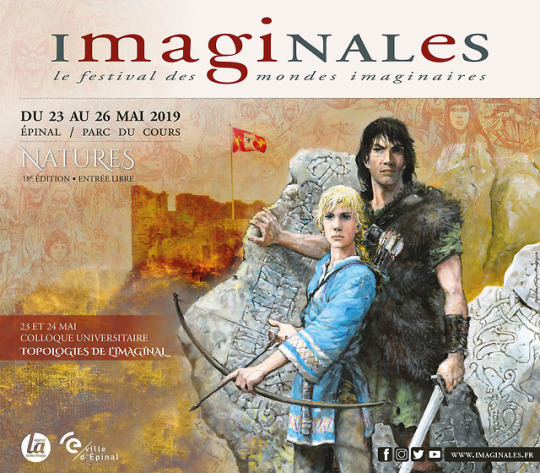
Imaginales: le festival des mondes imaginaires, 18ème édition. 23-26 May 2019, Ville d’Épinal, France. Poster art by Grzegorz Rosiński and Piotr Rosiński, info: imaginales.fr.
From Thursday 23rd to Sunday 26th May, 2019, more than 300 authors and illustrators from all over the world will come to Epinal, in France, for the 18th edition of Imaginales: le festival des mondes imaginaires, one of the first international exposition of Imaginative literature. Artists, novelists and experts in the Fantasy, SF and Fantastic genres will share their stories with a varied and enthusiastic audience. Founded in 2002, the festival is free and open to the public, welcoming more than 40,000 visitors from all over France.
Guest list:
Comics and illustration – Julien DELVAL, Renaud DENAUW, Emmanuel DESPUJOL, Steven DUDA, Gilles FRANCESCANO, Laurent GAPAILLARD, Armel GAULME, Didier GRAFFET, Loïc JOUANNIGOT, Milan JOVANOVIC, Frédéric MARNIQUET, Gilles MEZZOMO, Noë MONIN, Thimothée MONTAIGNE, Frédéric PILLOT, Michel RODRIGUE, Olivier ROMAC, Grzegorz ROSIŃSKI, Piotr ROSIŃSKI, Thierry SÉGUR, Olivier SOUILLÉ, Philippe ZYTKA.
International authors – Alex BELL, Sigridour Hagalin BJÖRNSDOTTIR, Peter BRETT, Anders FAGER, Mark HENWICK, Vic JAMES, S.T. JOSHI, Hildur KNÚTSDÓTTIR, Graham MASTERTON, Sam J. MILLER, Christopher PRIEST, Sofia SAMATAR, Johanna SINISALO.
French authors – Christophe ABAS, Sandrine ALEXIE, Nicolas ALLARD, Mel ANDORYSS, Jean-Pierre ANDREVON, Jacques BARBÉRI, Isabelle BAUTHIAN, Robert BELMAS, Paul BEORN, Karim BERROUKA, Georges BERTIN, Chloé BERTRAND, Pierre BORDAGE, Béatrice BOTTET, Nicolas BOUCHARD, Clément BOUHÉLIER, Charlotte BOUSQUET, Fabienne BRUGERE, David BRY, Sabrina CALVO, Nicolas CARTELET, Fabien CERUTTI, Fabien CLAVEL, Guy COSTES, Alain DAMASIO, Grégory DA ROSA, Nathalie DAU, Lionel DAVOUST, Nicolas DEBANDT, Romain DELPLANCQ, Jérôme DIDELOT, Julie de LESTRANGE, Marie-Charlotte DELMAS, Jean-Laurent DEL SOCORRO, Patrick K DEWDNEY, Romain D'HUISSIER, Victor DIXEN, Sara DOKE, Catherine DUFOUR, Jean-Claude DUNYACH, Silène EDGAR, Manon FARGETTON, Estelle FAYE, Franck FERRIC, Fabien FERNANDEZ, Élise FISCHER, Alexis FLAMAND, Célia FLAUX, Victor FLEURY, Jean-Pierre FONTANA, Isabelle FOURNIÉ, Thomas GEHA, Alison GERMAIN, Eric GIACOMETTI, Régis GODDYN, Marie-José GONAND, Alain GROUSSET, Lauric GUILLAUD, Colin HEINE, Johan HELIOT, Loïc HENRY, Ariel HOLZL, Raymond ISS, Jean-Philippe JAWORSKI, Gabriel KATZ, Florian KIEFFER, Katia LANERO ZAMORA, Gilles LAPORTE, Camille LEBOULANGER, Fabienne LELOUP, Christian LÉOURIER, Jérôme LEROY, Érik L'HOMME, Jean-Marc LIGNY, Méropée MALO, Eric MARCHAL, Jean-Luc MARCASTEL, Johanna MARINES, Jean MARIGNY, Danielle MARTINIGOL, Xavier MAUMÉJEAN, Patrick McSPARE, Hélène P. MÉRELLE, Sylvie MILLER, Vincent MONDIOT, Pierre PEVEL, Betty PICCIOLI, Stefan PLATTEAU, Jean PRUVOST, Jacques RAVENNE, Michael ROCH, Carina ROZENFELD, Éric SANVOISIN, Stéphane SERVANT, Floriane SOULAS, Charles SUZANNE, Ketty STEWARD, Rachel TANNER, Arthur TÉNOR, Philippe TESSIER, Nicolas TEXIER, Christophe THILL, Jean-François THOMAS, Jean-Christophe TIXIER, Adrien TOMAS, Jean-Michel TRUONG, Estelle VAGNER, Laurence VANIN, Cindy VAN WILDER, Claude VAUTRIN, Flore VESCO, Frédéric VINCENT, Frédérique VOLOT, Philippe WARD, Aurélie WELLENSTEIN, Georges ZARAGOZA.
6 notes
·
View notes
Text
TOUJOURS ROUGE MAIS SANS RAGE

Marc A. Bertin / Philippe Matsas - Leemage - Éditions Payot & Rivages
HERVÉ LE CORRE
Avec une douzaine de romans, presque autant de nouvelles et force distinctions, l’écrivain bordelais s’est imposé sans coup férir comme le patron du roman noir contemporain. Alors qu’il plonge dans les dix derniers jours de la Commune avec Dans l’ombre du brasier, la rencontre s’imposait.
Hiver 2019. Le fond de l’air est jaune. Il arrive, démarche posée. La moustache a disparu, les cheveux ont blanchi. On se souvient de l’enseignant, croisé quand il initiait des ateliers radio au collège Marcellin Berthelot, à Bègles, à la fin des années 1990. À l’époque, il n’avait que seulement trois polars dans la musette, mais tous parus à la Série noire. Reprenons. Nonobstant un patronyme breton, Hervé Le Corre est un enfant de Bacalan, rejeton aux racines brestoises, né et poussé en graine dans ce quartier à l’opposé du Café des Arts, où se déroule l’entrevue.
Dans ce quartier si loin, si proche, alors coupé par les ponts tournant et levant de la ville, « la classe ouvrière pouvait encore penser à un petit avenir devant elle ». Employés des douanes, dockers, petits fonctionnaires, majoritairement communistes, accédant enfin au confort moderne grâce aux HLM. « À 4 ans, ma famille s’installe à la Cité lumineuse. Nous habitions avant dans un appartement sans eau courante, chauffé aux boulets de coke. On a basculé dans une autre dimension, au bord de la Garonne, avec de la place pour jouer et l’école à deux pas. »
Bon élève et déjà rat de bibliothèque, dévorant Tout l’Univers, mythique encyclopédie, « reliée pleine toile rouge », à laquelle son père l’a abonné, mais aussi Akim, Blek le Roc et Prince Vaillant. « Et, vers 12 ans, quand tout le monde arrête de lire, je plonge dans le roman. C’est devenu une drogue dure. »
L’adolescent quitte les Bassins à flot, direction le prestigieux lycée Montaigne. La vie commence, se moquant des origines. « La jeunesse, en ces temps-là, était rebelle. Cela aplanissait les différences. » L’apprentissage militant aussi. Un peu par atavisme – père à la CFDT, mère « amoureuse de Rocard » votant PSU –, mais aussi telle une suite logique de l’environnement, « en Mai 68, mon père a fait un mois et demi de grève, occupant l’usine de Sud Aviation, les drapeaux rouges flottaient au fronton de la SAFT ».
1973, encouragé par son professeur de philosophie, un certain Patrick Rödel, le bachelier file en hypokhâgne et en khâgne. « J’étais intimidé par la perspective de la fac. En prépa, j’ai structuré ma culture, je suis enfin devenu intellectuellement adulte. » Brutal décalage dès la rentrée entre le fils modeste, militant LCR, et les progénitures d’enseignants et d’avocats. Son meilleur ami tient une semaine. Lui serre les dents, passant les concours pour le professorat même si le goût pour enseigner viendra sur le tard.
1978, le grand bain. Évitant l’exil des certifiés, il hérite du Médoc. Pauillac, en l’occurrence, avant le drame de la fermeture de la raffinerie Shell. Début calamiteux, bizuté deux mois durant avant de prendre le taureau par les cornes, « la générosité et l’humour sont deux puissants leviers pour trouver des complices ». Brutale confrontation avec le prolétariat rural, soumis aux rapports hiérarchiques, les élèves aidant leurs parents payés à la tâche pendant les vendanges, en ciré sous la pluie battante, la glaise à mi-mollet. « La grande misère de ces bouts de terre, aux structures moyenâgeuses. Ces bénéfices réalisés sur le dos d’ouvriers payés en barriques de vin déclassé. J’en garde une dent dure depuis… »
Inévitablement, vient la question : et l’écriture dans tout ça ? Par la poésie, mon ami ! En alexandrin et en mode automatique, sous influence surréaliste. Tout à la main. Certes, mais du vers au noir ? « Le Petit Bleu de la côte ouest, de Jean-Patrick Manchette, prêté par mon colocataire, dont l’oncle bossait en imprimerie. » Engrenage fatal : Dashiell Hammett, Raymond Chandler, W.R. Burnett, Horace McCoy, John Dixon Carr (« La Chambre ardente, un chef-d’oeuvre »), même Agatha Christie. La découverte spontanée, innocente en somme, tout en s’étourdissant de saveurs latino-américaines, García Márquez, Carlos Fuentes et Jorge Amado en tête.
Il entreprend des ouvrages, jamais aboutis, pensant que « c’était facile », pour autant, en écrivant, il découvre tant l’exigence que le plaisir. 1987, premier manuscrit refusé, toutefois accompagné d’une lettre d’encouragement de la Série noire. La cible n’est pas loin. 1990 : La Douleur des morts, « je me suis assis quand j’ai décroché le téléphone, incrédule, fier et heureux. J’avais envie d’écrire, fallait pas que ça s’arrête ». Sur les rails du néo-polar, il rejoint Jean Vautrin, Thierry Jonquet et Didier Daeninckx tout en se défendant de régionalisme, « j’invente des histoires se déroulant à Bordeaux, mais la ville n’est qu’un décor, en aucun cas un personnage. On pourrait les situer à Marseille ou à Saint-Étienne ».
Changement de décennie et crise. « Après quatre polars, j’en avais plein le cul, estimant avoir fait le tour. J’adresse donc un mauvais manuscrit sur l’affaire Papon à mon éditeur, qui me le retourne. Vexé, je décide d’arrêter d’écrire et de préparer l’agrégation, puis j’achète un recueil de Lautréamont. De là naîtra L’Homme aux lèvres de saphir. Quatre années de travail. J’écrivais autre chose, me sentant moins obligé d’être en prise. » La maturité ? « Qui sait ? Je suis passé du sprint à la course de fond. Un changement comme une bénédiction. Quel bien fou ! Cette bouée m’a sauvé, j’ai réappris à nager. »
Résultats : Grand Prix du roman noir français de Paris et prix Mystère de la critique 2005. Désormais, lui qui redoute de se retrouver prisonnier de lui-même, victime collatérale d’une écriture obsessionnelle, s’oblige à changer de sillon. Faut dire que sa compagne est sa première lectrice, intransigeante comme il se doit.
Cet admirateur de Jean Echenoz et de Laurent Mauvignier, rêvant d’une adaptation cinématographique façon La Soif du mal d’Orson Welles, ne concède aucune accointance dans la Police ni dans le Milieu, « quand on est trop technique, c’est un handicap. Mes flics ne sont pas collés au code de procédure pénale », préférant sonder les turpitudes. De même, l’homme de gauche ne mélange pas les genres. « Je n’écris pas car je suis engagé. C’est au citoyen de s’engager, pas à l’écrivain. Je n’ai jamais cherché à convaincre ou faire démonstration. »
L’arrestation de son confrère Cesare Battisti ? « Il s’est trompé de combat à une époque, mais c’est toujours un type bien. Je persiste et je signe. Amnistie devrait se traduire en italien. »
Dans l’ombre du brasier, Rivages/Noir.
Les Effarés, L’Éveilleur.
1 note
·
View note
Link
le dernier livre de Jérôme Bertin vient de sortir ! un Cas Soc’ de toute beauté, à cette occasion un article dans lib’critique sur l’écriture de Jérôme Bertin, en général, dans Cas Soc’ en particulier, petite étude de la page 9, par mes soins et de façon non-exhaustive…
3 notes
·
View notes
Text
NBA: Evan Fournier gets clashed
NBA: Evan Fournier gets clashed
NBA
Posted on July 14, 2022 at 4:35 p.m. by Jules Kutos-Bertin
Very frustrated by the original choice of the organizing committee of the Olympic Games, Evan Fournier complained on numerous occasions about the location of the main basketball tournament. Finally, handball will take place at Porte de Versailles. Philippe Bana, the president of the federation, did not fail to send a small spade to…

View On WordPress
0 notes
Text
NBA: Evan Fournier gets clashed
NBA: Evan Fournier gets clashed
NBA
Posted on July 14, 2022 at 4:35 p.m. by Jules Kutos-Bertin
Very frustrated by the original choice of the organizing committee of the Olympic Games, Evan Fournier complained on numerous occasions about the location of the main basketball tournament. Finally, handball will take place at Porte de Versailles. Philippe Bana, the president of the federation, did not fail to send a small spade to…

View On WordPress
0 notes
Text
Transports en commun enfin à La Réunion !
Il était temps.
Alors que les embouteillages sont quotidiens et que nos trajets s’éternisent, bloqués dans nos voitures pendant des heures, plusieurs projets de transports en commun sont proposés par La Région.
Face à l’évolution démographique à venir et aux problèmes de circulation quotidiens, le développement des transports en commun était plus qu’urgent.

Un monorail de Saint-Benoit à Saint-Philippe
Un projet de monorail porté par la Région, le Réseau régional de transport guidé (RRTG), prendrait forme à partir de 2020. Il relierait les villes de Saint-Benoit à Saint-Philippe en passant par le littoral Ouest.
Plus d’infos sur le projet
Réseau régional de transport guidé (RRTG): Début du chantier espéré à l'horizon 2020
Les Grands Projets Réunionnais de Transports, Déplacements, Intermodalité & Monorail, Le RRTG
Première section Nord entre Sainte-Marie et Saint-Denis
10 stations, 10 km en 20 minutes entre les pôles Duparc et Bertin.
La Commission permanente du Conseil Régional a validé la mise en place des autorisations du programme le 21 août 2018.
Plus d’infos sur le projet
Réseau Régional de Transport Guidé (RRTG) Section NORD
Les Grands Projets Réunionnais de Transports, Déplacements, Intermodalité & Monorail. Le Monorail
En attendant la fin des travaux, et les complications qui seront liées aux chantiers, optons pour le covoiturage.
Ces applications vous aideront :
Zeewa
Rundrive
1 note
·
View note
Photo

CORSI SETTEMBRE 2018
VERONA
Domenica 9 Settembre dalle 10,00 alle 14,00
CALLIGRAFIA ONCIALE
Condotto da Laura Toffaletti
Per info: [email protected]
10/17/24 Settembre dalle 19,00 alle 21,00
CORSO DI DISEGNO- Livello Base
Condotto da Isabella Bellinazzo
Per info: [email protected]
12/19/26 Settembre dalle 19,00 alle 21,00
CORSO DI ACQUERELLO- Livello Base
Condotto da Isabella Bellinazzo
Per info: [email protected]
18/20 Settembre dalle 19,00 alle 21,00
CALLIGRAFIA: CORSIVO INGLESE
Condotto da Laura Toffaletti
Per info: [email protected]
Domenica 23 Settembre dalle 10,00 alle 14,00
RILEGATURE FOGLI SCIOLTI
Condotto da Emanuela Monti
Per info: [email protected]
MILANO
15/16 Settembre
BIG DRAW: CORSO DI DISEGNO
Condotto da Maurizio De Bellis
Per info: [email protected]
22/29 Settembre
DISEGNARE CON LA PARTE DESTRA DEL CERVELLO
Condotto da Sara Vivan
Per info: [email protected]
Domenica 23 Settembre dalle 10,00 alle 14,00
CALLIGRAFIA: CANCELLERESCA
Condotto da Nicoletta Romanelli
Per info: [email protected]
Domenica 30 Settembre dalle 14,00 alle 17,00
LEGATORIA: LONG STITCH
Condotto da Susanna Carugati
Per info: [email protected]
PARIGI
Sabato 29 Settembre dalle 14,00 alle 18,00
CALLIGRAFIA ONCIALE
Condotto da Philippe Dabasse
Per info: [email protected]
FIRENZE
Domenica 16 Settembre dalle 9,30 alle 12,30
LEGATORIA: CROWN BINDING
Condotto da Valeria Castellani
Per info: [email protected]
Domenica 23 Settembre dalle 9,30 alle 12,30
CALLIGRAFIA CANCELLEESCA
Condotto da Simona Bartolini
Per info: [email protected]
GINEVRA
Lunedì 10 Settembre dalle 18,00 alle 20,00
CALLIGRAFIA:
Découverte des différentes lettres latines
Condotto da Dominique Zaugg
Per info: [email protected]
Giovedì 13 Settembre dalle 18,00 alle 20,00
BULLET JOURNAL
Condotto da Vénusia Bertin
Per info: [email protected]
Martedì 25 Settembre dalle 18,00 alle 20,00
BULLET JOURNAL
Condotto da Joelle Brizard
Per info: [email protected]
ROMA
Domenica 16 Settembre dalle 10,00 alle 14,00
CALLIGRAFIA: ITALIC BRUSH
Condotto da Gaia Dammacco
Per info: [email protected]
Domenica 30 Settembre dalle 10,00 alle 14,00
FILATURA DELLA CARTA
Condotto da Marcella Stilo di Cartalana
Per info: [email protected]
LONDRA
Domenica 16 Settembre dalle 10,00 alle 12,00
CANCELLERESCA
Condotto da Veiko Kespersaks of Calligraphystudio
Per info: [email protected]
2 notes
·
View notes